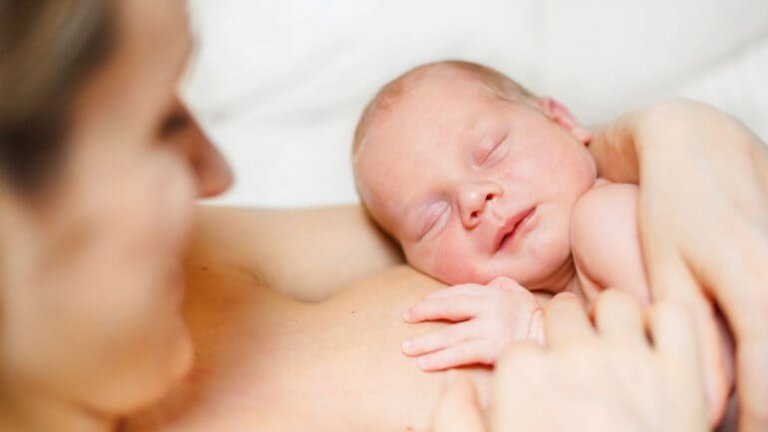The Golden Hour For Bonding With Your Baby

Bonding with your baby starts long before birth, and continues outside the womb. The entire process is important. Let’s not forget that motherhood begins from the first moment a woman begins to feel like a mother.
Birth and the moments immediately following it are a particularly sensitive time: a golden hour for bonding. However these moments unfold, they will leave a lasting mark on both mother and baby, laying the foundations for their relationship.
In these instants, both bodies are flooded with prolactin, oxytocin and beta-endorphins. These neurochemical substances are often known as the “molecules of love.”
Let’s just say that under normal conditions, what happens is love at first sight. The mother is besotted with her newborn. Meanwhile, the baby senses that their mother was their first home, and trusts her. In this way, a bond of affection forms between them.
The importance of first impressions: birth
Not long ago, the practice was to quickly swaddle the newborn, show the mother her baby, and then take them away to an incubator. New mothers were lucky to snatch a few moments to cuddle their little one.
Imagine what this treatment is like for a new baby, who for 40 weeks has been listening to their mother’s heartbeat as they bathed in the warm, dark comfort of the womb.

Over time, experts realized that, in fact, a mother’s arms were the best incubator of all. When a mother cuddles her baby and holds them against her skin, she does not just help to strengthen the bond of love between them. She also kick-starts the process of immunization, as the good bacteria that live on the mother’s skin can colonize the baby.
Similarly, we should not overlook the importance of the father at the moment of birth. The more he participates, the more engaged and committed he will be. This is why it is important for him to witness the birth of his child in all its splendor.
Physical contact: the key to a newborn’s development
As we have seen, bonds form during pregnancy and birth to connect the neurological, endocrine and immune systems of mother and child. These may hold the key to the child’s emotional and physical wellbeing.
One of the main forms of learning is through physical contact and cuddling. This is how a baby develops their ability to love and to trust. We instinctively maximize contact at this stage, communicating through cuddles and gestures of closeness.
Through these behaviors, we offer our children their very first lesson in emotional intelligence. Even if we don’t realize what we are doing, we are telling them that everything is OK, that we are protecting them and keeping them safe in their world.

The golden hour for bonding after birth
Most experts recommend that clinical staff respect the so-called “golden hour” after birth. This means that the mother has at least one hour to engage in skin-to-skin contact with her baby, without any interference or interruption. Cleanup, measurements and tests can almost always wait.
Specialists claim that skin-to-skin contact between mother and baby stabilizes the newborn’s breathing and the level of oxygen in their body. It maintains the right blood sugar level and blood pressure. It reduces stress hormones and calms crying babies.
This kind of contact can even ease the start of breastfeeding, helping the mother’s milk to begin flowing and reducing the baby’s risk of hypothermia.
This hour of skin-to-skin contact does not just facilitate the stabilization and regulation of these physiological processes, however. It is also a golden hour for bonding, naturally strengthening the connection between mother and baby.
Bonding with your baby starts long before birth, and continues outside the womb. The entire process is important. Let’s not forget that motherhood begins from the first moment a woman begins to feel like a mother.
Birth and the moments immediately following it are a particularly sensitive time: a golden hour for bonding. However these moments unfold, they will leave a lasting mark on both mother and baby, laying the foundations for their relationship.
In these instants, both bodies are flooded with prolactin, oxytocin and beta-endorphins. These neurochemical substances are often known as the “molecules of love.”
Let’s just say that under normal conditions, what happens is love at first sight. The mother is besotted with her newborn. Meanwhile, the baby senses that their mother was their first home, and trusts her. In this way, a bond of affection forms between them.
The importance of first impressions: birth
Not long ago, the practice was to quickly swaddle the newborn, show the mother her baby, and then take them away to an incubator. New mothers were lucky to snatch a few moments to cuddle their little one.
Imagine what this treatment is like for a new baby, who for 40 weeks has been listening to their mother’s heartbeat as they bathed in the warm, dark comfort of the womb.

Over time, experts realized that, in fact, a mother’s arms were the best incubator of all. When a mother cuddles her baby and holds them against her skin, she does not just help to strengthen the bond of love between them. She also kick-starts the process of immunization, as the good bacteria that live on the mother’s skin can colonize the baby.
Similarly, we should not overlook the importance of the father at the moment of birth. The more he participates, the more engaged and committed he will be. This is why it is important for him to witness the birth of his child in all its splendor.
Physical contact: the key to a newborn’s development
As we have seen, bonds form during pregnancy and birth to connect the neurological, endocrine and immune systems of mother and child. These may hold the key to the child’s emotional and physical wellbeing.
One of the main forms of learning is through physical contact and cuddling. This is how a baby develops their ability to love and to trust. We instinctively maximize contact at this stage, communicating through cuddles and gestures of closeness.
Through these behaviors, we offer our children their very first lesson in emotional intelligence. Even if we don’t realize what we are doing, we are telling them that everything is OK, that we are protecting them and keeping them safe in their world.

The golden hour for bonding after birth
Most experts recommend that clinical staff respect the so-called “golden hour” after birth. This means that the mother has at least one hour to engage in skin-to-skin contact with her baby, without any interference or interruption. Cleanup, measurements and tests can almost always wait.
Specialists claim that skin-to-skin contact between mother and baby stabilizes the newborn’s breathing and the level of oxygen in their body. It maintains the right blood sugar level and blood pressure. It reduces stress hormones and calms crying babies.
This kind of contact can even ease the start of breastfeeding, helping the mother’s milk to begin flowing and reducing the baby’s risk of hypothermia.
This hour of skin-to-skin contact does not just facilitate the stabilization and regulation of these physiological processes, however. It is also a golden hour for bonding, naturally strengthening the connection between mother and baby.
All cited sources were thoroughly reviewed by our team to ensure their quality, reliability, currency, and validity. The bibliography of this article was considered reliable and of academic or scientific accuracy.
- Bowlby, J. (1986). Vínculos afectivos: formación, desarrollo y pérdida. Madrid: Morata.
- Bowlby, J. (1995). Teoría del apego. Lebovici, Weil-HalpernF.
- Garrido-Rojas, L. (2006). Apego, emoción y regulación emocional. Implicaciones para la salud. Revista latinoamericana de psicología, 38(3), 493-507. https://www.redalyc.org/pdf/805/80538304.pdf
- Marrone, M., Diamond, N., Juri, L., & Bleichmar, H. (2001). La teoría del apego: un enfoque actual. Madrid: Psimática.
- Moneta, M. (2003). El Apego. Aspectos clínicos y psicobiológicos de la díada madre-hijo. Santiago: Cuatro Vientos.
This text is provided for informational purposes only and does not replace consultation with a professional. If in doubt, consult your specialist.








